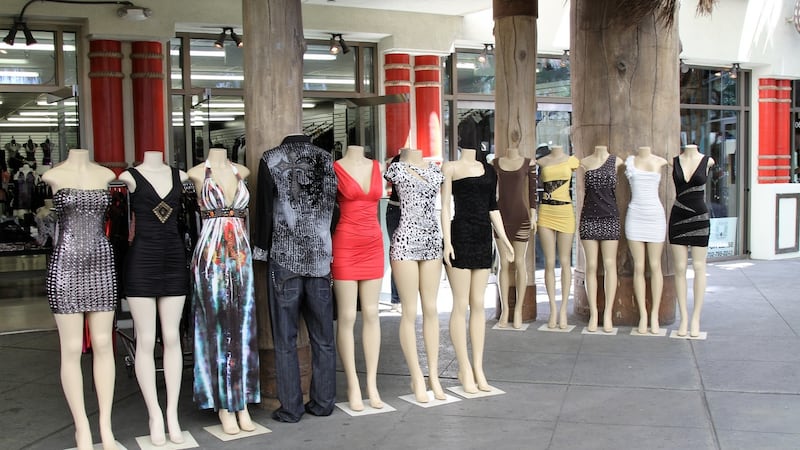Bra tops, tiny skirts, “bodycon” dresses, and plunging necklines – the “going out” clothes currently favoured by many teenage girls – can provoke conflict and concern for parents.
But are parents over-reacting?
According to Fidelma Beirne, senior social worker with Crosscare Teen Counselling, conflict over clothes is one way teenagers work out “individuation” – forming their own identity – and “detachment” – the changing relationship with parents as they become more independent.
Peers, meanwhile, hold more power than parents as influencers, observes Fidelma. “The young person will say, ‘I should be allowed make choices about my body and myself’, and then say, ‘everyone is wearing it’. This is the paradox, they want to be individuals, but they are individuals as part of a crowd.”
An informal survey of parents throws up no surprises. While some feel their daughters should dress how they want, common themes for disagreements emerge. These include: “too skimpy”, “too short” and “ not age appropriate”.
As Denise Cavanagh’s 13-year-old prepared for her first disco she showed her mother dresses online. “The first few were bare beyond belief so I looked through the site with her and we agreed on a dress which I felt had plenty of coverage. The dress arrived in an envelope that fitted through the post-box. It was nylon and light as a feather, and while it might have been okay on an 18 year old, it looked like she was wearing a slip.
“I swiftly took her to town and found a not too short skirt, and a lace top that met the waist of the dress. On the night, she looked good, she could keep her dignity and my nerves remained intact – until next time!”
Testing boundaries
“At the 12 to 14 stage, what is often going on is the testing out of curiosity and risk,” explains Beirne. “Albeit, they don’t know it themselves, they are testing boundaries and looking for guidance on what is okay and what is not. Fourteen and 15-year-olds will really be pushing the boundaries, so you have to watch that, but by 16/17/18 parents have to understand that they are moving towards independence and maybe say less.
“However, parents should always be able to say, ‘no, that’s not okay’. Every parent will have a bottom line, but everyone’s bottom line seems be very different.

“There are no rules that a skirt so many inches long is too short. It might seem easier sometimes if there were rules. Different standards will apply to different ages. What you refuse to let your 13-year-old wear may be up for negotiation with your 15-year-old, and totally alright for a 17-year-old to choose, though you may not like it.”
Where the greatest conflicts can erupt, she adds, is when teenagers insist, “I can buy what I like with my own money”.
“Who’s paying for it is often an underlying issue,” says Beirne.
There is a reality we have to accept about the messages that clothes send
So, are parents worrying without reason?
“I don’t think a parent being worried about a 12-year-old heading out in short skirt and stilettos is wrong to be worried,”says Beirne. “Their concern is about what is age-appropriate. Parents are concerned that if their teen is perceived to be older that they will become involved with older teenage activity.
“I think there is a reality we have to accept about the messages that clothes send. Parents are showing their teens how to dress differently depending on the context – eg friend’s party versus lunch with granny. This is not just about the girls, it’s not just a ‘sexualised’ thing. Parents have worked out that society makes assumptions about how we dress. There can be assumptions about girls wearing particular clothes in the same way as boys wearing tracksuits, or adults wearing pyjamas to the shops.”
Beirne sees arguments over clothing as part of a transitional phase for teenagers, but says parents need to engage in conversation, rather than just say, “no”.
How differences are discussed is also important, she says. “You are trying to give the right message, but that message can be given in a really negative way, like if somebody tells their daughter, ‘you look like a hooker’. This does not open up the possibility of discussion and understanding. It closes down communication. Teenagers are experimenting with multiple identifies.
“When counselling that parent, we would try to get them to remember that their daughter is experimenting, and just because somebody views the clothes she is wearing in a particular way doesn’t mean she shouldn’t wear it – unless it’s at the real extreme for that particular age group.”
In my mind, it's mostly people from outside the 'group' – elders, etc – who attribute 'meaning' to the clothes teens wear
Mary Therese Fitzpatrick, who's daughter is 17, believes that because teenagers socialise in groups from similar backgrounds they "don't over-interpret dress codes".
“In my mind, it’s mostly people from outside the ‘group’ – elders, etc – who attribute ‘meaning’ to the clothes teens wear,” she says. “I might not like what she’s wearing or even think it suits her, but I decided it was a battle I wasn’t going to fight. In parallel – and probably not on the same night as I see her in something ridiculous! – I would try to engage with her on clothes/dressing, what looks nice, etc .”
So how can parents diffuse or avoid arguments? Asking questions such as “What might granny think about it?” can be a start suggests Beirnea, with perhaps rephrasing it for the current generation.
“Ask: ‘Is this wise? Would you be okay with a summer job boss seeing this on Facebook? Would you get the job?’”
Intervening early is also important. “Parents often know in advance what their daughter plans to wear, so that is the time for the conversation. If they are coming down the stairs to go out, and a friend has sneaked something in for her to wear, a parent has to evaluate – should I deal with this now, or can it wait? If it’s a 12-year-old coming down you might need to intervene. However, if they are 16 or 17, you need to think about it. If you get into it right there and then, are you going to create a bigger problem?”
The aim, says Beirne, is to help adolescents self-regulate so that they can make good choices for themselves, “It’s all about helping them to become comfortable in their skin, so that when they are making choices for themselves, that they don’t feel they have to follow the crowd.”
In quotes: what the parents say
“We’ve had constant rows about clothes. She says if she wore what we thought was okay she’d be laughed at.”
“Dressing like your peers in clothes that horrify your parents is a rite of passage”
“She came down in an outfit borrowed from a friend. It was more or less two strips of flesh-coloured fabric, one across her top and the other across her bottom. She couldn’t understand what my problem was!”
“I think for most girls their choice of clothes is just another form of ‘uniform’ – they just want to be the same as everyone else.”
“They love dressing up. Sometimes I think it’s like when they were toddlers wearing my high heels and clothes around the house, but it’s just not cute anymore!”
“Against my better judgment I gave her permission to go to a ‘gaff’ and we agreed on an outfit. She was staying in a friend’s house. Her sister told me she looked nice on Facebook so I glanced at the photo on her phone. She was wearing a bra top that we had rowed about previously and we had told her was suitable only for the beach. I texted her to say how annoyed I was, and when she got home we had a huge fight.”
“When they come to get ready the bags of make-up are huge and the clothes would fit in their pockets. I don’t know whether to laugh or cry when they come downstairs.”
“The main problem is when they are going to a disco. With my first I found it particularly hard . Issues were mainly around the length of skirt and low revealing tops . I’d like to say I stood my ground and didn’t let her out in inappropriate clothes but it was/is very hard as they feel an enormous pressure to dress like that and sadly everyone else does seem to do the same.”
“There have been some compromises and definitely as she gets older the clothes are slightly less revealing.”
“Once they are not in a school situation I have always let them wear what they want. Perhaps that’s not protecting them, but I wouldn’t accept that they have any personal responsibility for the signals that other people take from what they wear. I hope I’ve empowered them to know that they are in charge of their own bodies.”
“I allowed my 13-year-old to go shopping in Dundrum by herself with friends. She bought (with her own money) two very skimpy, off-the-shoulder short flared tops. One white and near see-through. I was horrified and asked her to bring them back. She wouldn’t. We argued about when and where she would wear them. I couldn’t think of any suitable time. She thought on holiday at the beach. Thankfully, her dad didn’t like them either and said so. She returned them. However, I did see an Instagram pic of her friend wearing one of the same tops in the park!”
“I hate the social norm of girls wearing minimal and figure hugging clothing when ‘going out’. Once I’ve insisted on something else being worn, but I felt awful because there was a gang here when I took her aside.”
“In future, I will meet her in the shops to see what she has picked out and guide her to choose something less trashy when I disapprove. However, part of me thinks that they are young and have the figures so why not let them wear the skimpy clothes. They won’t be wearing them in 10 years’ time.”
“She came home from school with two tops she had borrowed for a disco that night. Both were like wide hair bands and soiled with fake tan. She still thinks we were ‘soooo stupid’ not to allow her go out in one of them.”
“We have come to a sort of compromise. Either the skirt is short, or the top is.”
“Her usual argument is that wearing what we think is appropriate would be ‘social suicide’ for her. Her dad tells her she can stay in so, to prevent embarrassment. That usually tends to focus her mind on changing her outfit.”
“At the local Junior Cert disco everyone was baring flesh. I think there is social pressure to do this”
“Rightly or wrongly I have not made an issue about the clothes she wants to wear. These girls have a great social life now and rather than encourage her to spend time/money shopping for new clothes every other week, I’m happy for her to swap with friends and of course a consequence of this is that she wears more or less what everyone else does so I can’t really argue.”
“Their response is why is there such a big deal – everyone should be able to wear what they like, but they do agree that what you wear says something about you! Talking to them about clothes also did start a conversation about how the boys dressed in jeans and teeshirts/ shirts, and why this was different to what the girls wore”
“The last time I sent her up the stairs to change she reminded me that she’s almost 17, and that if the law considers her mature enough legally to consent to sex at 17 surely she’s mature enough to decide what to wear herself. To be fair she had a more reasoned argument than my ‘you’re not wearing that out . . . ’.”










